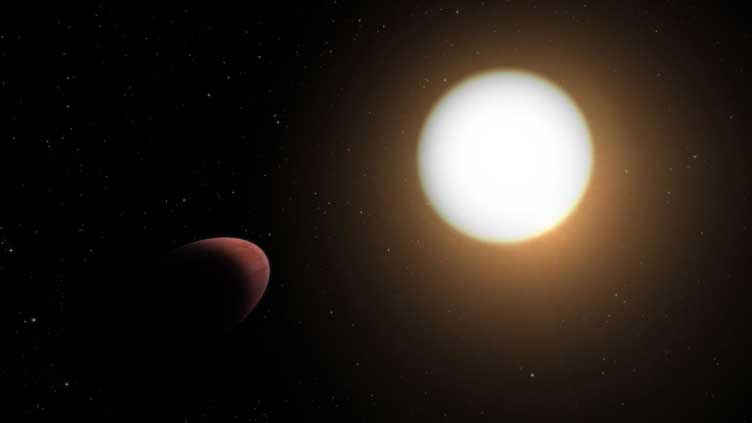Alien planet found orbiting towards its end

WeirdNews
Alien planet found orbiting towards its end
(Web Desk) - Astronomers have discovered an exoplanet orbiting an evolved, or older, host star for the first time. The devastated planet seems doomed to spiral toward its developing star, where it will eventually collide and be destroyed.
By offering the first glimpse at a system at this advanced stage of history, the discovery provides fresh insights into the drawn-out process of planetary orbital decay.
In the course of billions of years, when our Sun ages, the Earth may meet the same fate as many other worlds: death by a star.
Shreyas Vissapragada, a 51 Pegasi b Fellow at the Center for Astrophysics | Harvard & Smithsonian and the lead author of a new study describing the findings, says, “We’ve previously detected evidence for exoplanets in spiraling toward their stars, but we have never before seen such a planet around an evolved star.” We can now use measurements to test the theory that evolved stars are highly good at sapping energy from the orbits of their planets.
The unfortunate exoplanet is known as Kepler-1658b. The exoplanet was found by astronomers using the Kepler space telescope, as its name suggests, a ground-breaking planet-hunting project that debuted in 2009. Strangely enough, the world was the first candidate for a new exoplanet that Kepler ever found. However, it took over ten years for the planet’s existence to be established, at which point it was formally added as the 1658th object to Kepler’s catalog.
A hot Jupiter, also known as an exoplanet with a mass and size comparable to Jupiter but in swelteringly close orbits to its home star, is Kepler-1658b. Only an eighth of the distance separates our Sun’s closest circling planet, Mercury, from Kepler-1658b. Orbital degradation appears to end in catastrophe for hot Jupiter and other planets like Kepler-1658b that are already quite near to their sun.
Because orbital degradation of exoplanets occurs slowly and gradually, measuring it has proven difficult. According to the latest research, Kepler-1658b’s orbital period is getting shorter by just 131 milliseconds (thousandths of a second) a year, which indicates that the planet has migrated closer to its star.
This deterioration was only discovered after several years of diligent study. Kepler initiated the watch, which was later picked up by the Hale Telescope at Palomar Observatory in Southern California and ultimately by the Transiting Exoplanet Survey Telescope (TESS), which was launched in 2018. When an exoplanet crosses the face of its star and causes very little dimming of the star, the phenomenon is known as transit and was observed by all three instruments.
The time between Kepler-1658b’s transits has gradually but noticeably shrunk during the past 13 years.
The same mechanism that causes the oceans of Earth to rise and fall on a daily basis, tides are the primary cause of the orbital degradation that Kepler-1658b experienced. Gravitational interactions between two circling bodies, such as our planet and the Moon or Kepler-1658b and its star, produce tides. The bodies’ gravitational pulls alter each other’s forms, and as they adjust, energy is released. These tidal interactions can cause bodies to push one another inward, as with Kepler-1658b toward its star, or outward, as with the Earth and the Moon, depending on the distances, sizes, and rates of rotation of the bodies involved.
Particularly in star-planet settings, researchers still have a lot to learn about these dynamics. So, more research on the Kepler-1658 system ought to be useful.
The star has reached the stage in its stellar life cycle where it has begun to grow, as is expected of stars like our Sun, and has entered what astronomers refer to as a subgiant phase. Compared to unevolved stars like our Sun, evolved stars as the Sun should more easily because the tidal energy received from hosted planets’ orbits dissipates. As a result, the orbital decay process accelerates, making it simpler to investigate on a timescale that is relevant to humans.
The findings contribute to explaining Kepler-1658b’s inherent peculiarity, which is that it seems brighter and hotter than anticipated. The team hypothesizes that the tidal interactions that are causing the planet’s orbit to contract may also be producing extra energy within the planet itself.
The most volcanically active body in the Solar System, Jupiter’s moon Io, has a similar condition, according to Vissapragada. Io’s interior is melted by Jupiter’s gravitational pressure and pull. This molten rock then bursts onto the moon’s infamously infernal surface, which is covered in fresh red lava and yellow sulfur deposits.
Celestial body interactions should become clearer with the addition of more Kepler-1658b observations. Vissapragada and colleagues anticipate that TESS will find many more cases of exoplanets circling down the drains of their host stars as it continues to examine thousands of neighboring stars.
We can now begin to improve our models of tidal mechanics because we have proof that a planet formed around an evolved star, according to Vissapragada. In this sense, the Kepler-1658 system can act as a celestial laboratory for years to come. Hopefully, there will soon be a large number of these labs.


